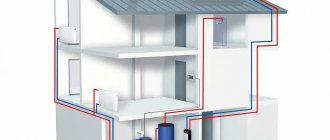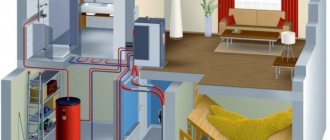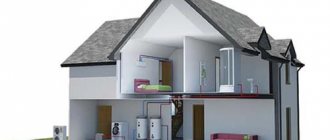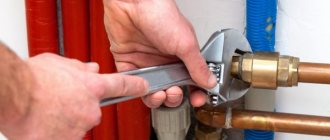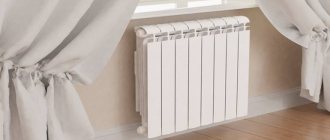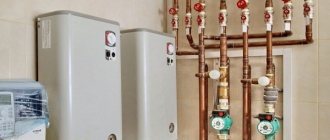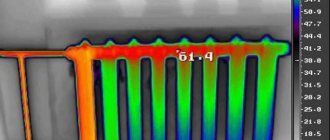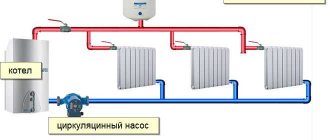Advantages and disadvantages of a water heating system
The main disadvantage of water heating in a private home is the need to purchase a large number of different materials. Namely: pipes, shut-off valves, fittings, radiators, boiler and circulation pump. The latter is not used in all systems.
And other shortcomings that can be described as nonsense if the owner of the house is indifferent to his home:
- Water leaks during operation. Today this situation is rare because plastic pipes have been replaced by plastic pipes. But even they sometimes leak at the junctions with other materials. These are already claims against the installation manufacturer.
- The water inside the system may freeze if it is not drained for the winter. This situation is for houses that are not used during the cold season.
Plastic pipes have solved many problems
Water heating has more advantages, which is why the majority of developers of new houses choose it:
- uniform distribution of heat throughout all rooms;
- installing one heating boiler makes it possible to control the process from one place;
- all equipment, except radiators, and piping can be made hidden. That is, organize a boiler room in the office space, and hide the pipes in grooves on the walls or in the floor. Using a heated floor system generally solves the problem of hidden installation. Even the radiators will not be visible;
- The coolant temperature does not exceed +95°C. And the surface of the batteries heats up to +65°C. You can’t get burned on them; dust doesn’t burn on them;
- water heating produces soft heat.
Heating system with hidden pipe wiring
Heating system costs
There are 2 types of heating system costs:
- Capital;
- Operational.
Capital – the cost of boilers, heating appliances, pipes, other materials and equipment. Operating – costs during use of the heating system.
Reducing the costs of boiler units, automation systems, and heating circuits leads to high costs during the operation period. And vice versa - the installation of highly efficient heat-generating installations, a modern automation system, and optimal equipment configuration can significantly reduce costs when using heating. In addition, choosing the optimal heating system design will significantly increase indoor comfort.
Regardless of the choice of heating system, when installing it, it is better to trust professionals who will carry out the design and installation work themselves.
Professionals will choose the most suitable equipment and the optimal wiring diagram and coolant supply system.
More about heating systems: types, features, choice for businesses and private homes; can be found at the exhibition "Electro"
Transformer substationStreet lightingStreet lamps
Features of a water heating system
From the name itself it becomes clear that the coolant in this case is water. This is the environment that accumulates thermal energy well and releases it easily. It has a high heat capacity, expands when heated, but contracts poorly when pressure increases. Water density is 950 kg/m³. The principle of operation of water heating is quite simple. The water is heated in the boiler, and then moves through pipes to the radiators, where it gives off its heat, and returns through the return circuit to the boiler.
How the coolant moves through the heating system
The main task of the heating assembly is to force the coolant to move along the circuit. Therefore, there are two types of heating systems: with natural circulation of coolant and with forced circulation. In the first case, water moves through the pipes under the influence of physical laws, when the warm medium rises up and the cold medium goes down. In the second, movement occurs due to the operation of the circulation pump. But more on that below, and now let’s look at what materials and equipment are best to choose for installing water heating.
What does the heating system consist of?
Quite often, the heart, the main element of any heating system is the boiler.
It is he who heats the coolant, the task of which is obvious - to spread heat throughout the house. And, of course, liquid can best cope with this task. In most heating systems, it is customary to use water as a coolant. A system with a coolant of this type is made closed. That is, the water in it circulates around the ring, and adding coolant is required extremely rarely.
Today, the two-pipe heating system, which is shown in the photo, is recognized as the most reliable and practical:
Two-pipe heating system
It consists of two circuits closed on the boiler - coolant supply and return. The first serves to supply the liquid heated in the boiler to the radiators, where it gives off its heat. After cooling, the coolant returns through the return pipes to the boiler for reheating. At the same time, the most rational and most effective is the parallel arrangement of radiators - thus, they warm up at the same time, which makes it possible to uniformly warm up all rooms
It is important to remember that the heating efficiency is affected by the distance between the coolant supply and return circuits. The permissible minimum is the height from the window sill to the floor
It should be admitted that they are partly right - after all, due to the passage of coolant through pipes and components, a certain loss of coolant occurs. However, we should not forget that stove heating does not make it possible to heat all rooms evenly at the same time. In addition, using a stove is very inconvenient due to the need to store a large supply of firewood. If you use a wood-burning boiler, much less fuel is required.
Stove heating at home
Most often, a fairly simple and at the same time very effective two-pipe heating system with natural coolant circulation is used. It allows you to heat your house with high quality without using additional equipment - electric circulation pumps. The reason for the popularity of this heating system for private houses is explained by the fact that there are frequent cases of power outages - and in this case (without electricity), the system simply will not be able to work.
One of the main requirements, which is extremely important to comply with for the further operation of the system, is to create the maximum possible difference in height between the outlet of the system and the highest point of the system. That is why the most rational option is to locate the boiler with a pipe in the basement.
If there is no basement, the boiler is installed in a recess on the ground floor. No less important is the creation of a slope for the return line. It is performed horizontally, starting from the first radiator of the system.
Heating boiler in the basement of a private house
In a heating system of this type, there is one more mandatory element - an expansion tank.
It is used to create maximum pressure in the system, which is extremely important for normal circulation. The operation of the tank is based on the usual gravitational principle
It should be placed as high as possible - the ideal place would be the attic. It is the height of the location, and not the amount of liquid in the tank, that determines the pressure.
It should be remembered that such heating systems for a private home can only operate correctly if the coolant is water. A system with this principle of operation of the expansion tank is called open.
Heating expansion tank
Closed systems are those in which the expansion tank is in no way connected to the outside world. That is, it does not have the ability to pump out coolant. In such a system it is customary to use a compensation tank. This is a small container, the internal cavity of which is divided into two parts by a flexible membrane. One of the parts is filled with coolant. The pressure in the system is regulated by bending the membrane in one direction or another. Since the system is closed, this allows antifreeze to be used as a coolant.
Basic elements of water heating
The water heating system includes:
- heat generator, also known as a boiler or furnace;
- pipes;
- radiators;
- circulation pump;
- expansion tank.
Complete set: boiler, radiators, pump and expansion tank
Heating boilers
Before purchasing and installing a heating boiler in a private home, you need to calculate its power. This indicator reflects the amount of thermal energy supplied. And the larger the area of a private house, the more powerful the equipment must be installed.
Gas generator for heating a private house
It is easy to calculate the power of the unit. To do this, you need to know one ratio - for 10 m² you need 1 kW of thermal energy. This takes into account that the height of the ceilings in the rooms is no more than 3 m. But it is necessary to understand that this ratio will act differently in different climatic regions. Therefore, SNiPs contain climate coefficients.
| Region | Northern | Middle lane | Southern |
| Coefficient | 1,5-2,0 | 1,0-1,2 | 0,7-0,9 |
For example, the total area of a private house located in Murmansk is 100 m². The boiler power is determined as follows:
- 100 / 10 = 10 kW;
- 10 x 2 = 20 kW , where “2” is the northern coefficient.
Liquid fuel boiler assembly
Now, regarding the classification. Heating units are mainly divided according to the type of fuel used: gas, electric, solid or liquid fuel. If gas is installed in the house, then this is the best option. All other types are considered taking into account what is beneficial. If the power supply is inconsistent or the network voltage is weak, then it is better to give preference to solid fuel boilers. By the way, the latter are not only wood-burning structures, they are modern pellet options, which have wider functionality and higher efficiency.
Solid fuel wood boiler in operation
Attention! Purchasing a boiler is not cheap, so fireplaces and kitchen stoves in which a heat exchanger is installed can be used as heating generators.
Electric heating boiler
Related article:
Long-burning wood-fired boilers for the home. From this publication you will learn everything about wood-burning boilers, their types and nuances of use.
Pipes
Everything is simple here - you only need to use the plastic version. Pay attention to its temperature limit for use. Because there are pipes for cold water and for hot water. In heating, the second position is used.
Plastic pipes for heating
You can talk about the diameter of the pipes only after a full calculation of the system. But first we can say that material with a diameter of less than 40 mm cannot be used for the supply and return circuits. Radiator connections are products with a diameter of 20-25 mm.
Related article:
Heating pipes: which ones are better. Varieties of products, their advantages and disadvantages, how to choose the right diameter, how to insulate - you will find all this and much more in our publication.
Radiators for heating
Manufacturers today offer four types of heating batteries:
- cast iron,
- steel (tubular or panel),
- aluminum,
- bimetallic (steel pipes inside, aluminum on top).
Cast iron radiator - accordion
Related article:
What heating radiators are best to install in an apartment. In this review we will look at the types of radiators, their advantages and disadvantages, popular models and manufacturers.
Each type has its own pros and cons. For example, cast iron heats up slowly, but retains heat for a long time. Aluminum heats up quickly, gives off the most thermal energy, but quickly corrodes. In this regard, the best option is bimetallic or steel, as the golden mean.
Steel tubular radiator
It is important to calculate the required number of battery sections, because this value determines how much heat will be released into the rooms of the house. It is not difficult to do the calculation yourself. To do this, you need to know the area of the room, the average heat transfer value of one section, and also take into account the ratio of the area of the room and the heat transfer from the radiator. The latter is the range of 60-200 W depending on the climate region.
Aluminum model with the highest heat output
For example, the area of a room is 20 m², the average heat transfer value of one section is 170 W, the ratio is taken to be 100 W. The last two indicators can be found in SNiPs. Now we carry out the following mathematical operations.
- 20 x 100 = 2000 W of heat will be required to heat the room;
- 2000 / 170 = 11.76 pieces or 12.
That is, it turns out that in order to heat a room of 20 m², you will need a radiator battery with 12 sections. Of course, this is an approximate calculation, because the ceiling height and battery type were not taken into account.
Bimetallic batteries with high heat dissipation efficiency and long service life
| Cast iron | Steel | ||
| pros | Minuses | pros | Minuses |
| High heat capacity | High specific gravity | High strength | They are afraid of water hammer |
| Long service life | Exclusive models are very expensive | High heat dissipation | In the absence of water, corrosion processes begin to occur |
| Withstands pressure up to 22 bar | Unpresentable appearance of accordions | Two types: tubular and panel | |
| Low price | Low impact strength | Low price | |
| Requires a small volume of coolant | |||
| Aluminum | Bimetallic | ||
| pros | Minuses | pros | Minuses |
| Highest heat output | They are afraid of water hammer | Withstand high pressure | Not the highest heat transfer compared to other models |
| Low specific gravity | Subject to corrosion | Easily cope with water hammer | Not the lowest price |
| Short service life | Very easy installation | ||
| High resistance to corrosion processes | |||
Especially for our readers, we have developed a convenient calculator for calculating the number of radiator sections.
Calculator for calculating the number of heating radiator sections
Expansion tank
Before heating a private house, you need to think through all the positions so that the end result does not disappoint. Therefore, choosing the type and volume of the expansion tank is the most important component of the installation process. Its only purpose is to absorb water, the volume of which has increased due to heating. An additional function is to remove air from the system.
Expansion tanks for heating are always red
The expansion tank can be open or closed. The first is a regular container with an open top end. That is, water comes into direct contact with air. It is usually installed above all other heating units. Warm water gradually evaporates through the open neck, so it will need to be added periodically. The second is a sealed vessel, inside of which there is a rubber membrane. Stretched by water, it creates pressure inside the system, which helps the movement of the coolant. Typically, a closed model is installed with a circulation pump. There is no mandatory requirement to install high. That is, the tank is installed in any convenient place.
As for its volume, this figure is 15% of the coolant volume. The latter is not easy to calculate. You will have to find out the volume of water that is placed in the boiler (in the passport data), in the radiators (ibid.), in the pipes. The latter will need to be calculated using the formula for the volume of cylindrical figures, taking into account the length and diameters of the pipes. It is much easier to use a calculator specially developed by our team, which takes into account all the complexities of the calculation.
Calculator for calculating the volume of an expansion tank for a heating system
Circulating water pump for heating a private house
This device is used only in systems with forced circulation of coolant. It is convenient because pressure is created inside the pipework, which increases the speed of water movement. In this way, the coolant is evenly distributed over the radiators.
Circulation pump for moving coolant
The main parameter of a water pump for heating a private house is performance. To calculate it, the formula is used: Q = N/1.16x(tout-tin), where N is the power of the generator, tout and tin are the coolant temperatures at the outlet and inlet of the boiler, “1.16” is the heat capacity of water. Temperature difference is a parameter that needs to be measured. But it is impossible to do this if the heating system is not yet turned on. Therefore, there are average indicators.
| Heating type | Radiator | With installation of convectors | Warm floor system |
| Temperature difference, C | 20 | 15 | 5 |
How to install the pump correctly
Circulation pump performance calculator
Circulation pump pressure calculator
Classification of water heating systems
As mentioned above, heating is divided according to the method of movement of the coolant into: natural circulation and forced.
Heating system with natural coolant circulation in a one-story house
Let’s immediately make a reservation that a heating system with natural circulation is best used in one-story houses. The thing is that the coolant cannot rise high even at a temperature of +95°C. Of course, no one limits the height of the distribution; it’s just that the system itself will work ineffectively.
Schematic diagram of heating with natural circulation of hot water
The essence of natural circulation is the movement of water under the influence of the laws of physics. But there is one nuance here that you need to know when installing heating yourself. This is the slope of the horizontal contours from the boiler towards the radiators and from the radiators to the boiler. This figure should be at least 0.5%. That is, this is enough to force the water to move by gravity.
Attention! The advantage of this scheme is complete independence from electricity.
What you need to pay attention to when installing heating without a pump:
- The boiler must be located in the lowest place relative to all pipework. The optimal height difference is 0.5÷1 m.
- The expansion tank is installed above the entire pipework. The height difference is up to 0.5 m.
- The riser leaving the boiler must be directed vertically upward.
- The speed of coolant movement in the system must be no less than 0.1 and no higher than 0.25 m/s. To achieve this, it is necessary to accurately calculate the diameter of the pipes used, taking into account the temperature of the water at the outlet and inlet.
- If heating of this type is equipped with a closed expansion tank, then it is installed at the level of the boiler. In this case, it is necessary to install an air vent into the system, which must be installed at the highest point of the pipe distribution.
Scheme with forced water circulation
Heating diagram for a one-story house with forced circulation of coolant
This scheme differs from the previous one not only in the presence of a pump, but also in the location of the pipes. There is no need for installation at an angle. This is very important for those who are assembling a heating circuit for the first time.
But there is one very important nuance in this system.
Attention! The pump must be installed on the return circuit near the boiler. It is in this area that the coolant temperature is lowest. And this is important for the pump, or more precisely, for its rubber gaskets and cuffs, which simply cannot withstand high temperatures. They will begin to shrink and burst, which will lead to leaks and failure of the pumping unit.
Correct pump installation location
It should be noted that the heating scheme with forced circulation can be used not only for one-story houses. If you accurately calculate the power of the circulation pump, it will easily pull several floors. Although experienced plumbers recommend installing several boilers with separate pumps for a large house with several floors.
Related article:
Heating a country house: options and prices. A separate review provides a comparative analysis of various heating methods with tips and recommendations.
Heating water requirements
Special laboratory tests will help determine what kind of water to pour into the heating system.
Experts analyze the samples provided and make a conclusion about whether the chemically purified water for heating meets state standards for:
• dissolved oxygen content (not more than 0.05 mg/cubic m);
• acidity level (acceptable range from 8 to 9.5);
• hardness (from 7 to 9 mg eq/l.);
• iron concentrations within 0.5-1 mg/l.
Of particular importance is the hardness indicator, if increased, there is a risk of lime deposits forming and system breakdown. A special water softener for the heating system, which successfully combats magnesium and calcium salts, can solve the problem. Another option is chemically purified water for heating (water that is absolutely free of impurities is called deionized), but with such treatment it is necessary to constantly maintain a certain concentration of reagents and control changes in the level of hardness. Additionally, tests are carried out to confirm the absence of pathogenic microorganisms that could cause a film to form inside the pipes.
Radiator connection diagrams
For ordinary people who do not think about how radiators are connected in their own home, it does not matter what circuit is used. The main thing for them is warmth in the house. But, as practice shows, it is the connection diagram of radiator batteries that affects the quality of heat transfer. And there are two schemes: one- and two-pipe.
How to make a one-pipe heating system for a private house with your own hands
First of all, you need to understand why it is called that. In essence, a single-pipe is a ring with a boiler in the center. The pipes are laid close to the floor in a circle, with batteries connected to them. Each of them takes the coolant from one side from the lower pipe and squeezes out already cooled water into the same pipe from the other opposite pipe (lower).
Let's face it, it's not the best option, because it has one significant drawback. The radiators far from the boiler receive coolant with a significantly reduced temperature. That is, the batteries closest to the boiler will be hot, the ones farther away will be warm. This means that some rooms will be cool.
Single-pipe with connection of radiators to one circuit
But if a private house is small with 3–6 rooms, then a single-pipe heating system in it is justified due to the ease of installation with your own hands, plus a small number of pipes, shut-off valves and fittings. That is, this is the most economical option in terms of construction. Although the scheme and procedure for installing single-pipe heating are considered simple, the responsibility of the operations carried out is still high. This is especially true for systems with natural coolant circulation. Here it is important to accurately observe the slope of the pipework.
Two-pipe scheme
This water system is more complex for installation work, plus it uses more materials. But it works much better than a single-pipe one. Purely structurally, the layout of the pipes in it consists of two circuits: supply and return. It should be noted that both pipelines are blind and are connected to each other only through radiators and a heating boiler. From the names themselves, it becomes clear that heated coolant is supplied to the radiators through the supply circuit, and cooled coolant is discharged to the boiler through the return circuit.
In this case, radiators can be connected to the supply circuit in different ways. Option one is a circuit with lower wiring. This is when the coolant supply pipe runs along the floor with a connection to the upper radiator pipes. The return is carried out right there, but with a connection to the lower pipes of the heating batteries.
Two-pipe with bottom wiring
The second option is a top-wiring scheme. This is when a pipe riser is drawn upward from the boiler, which goes into a circuit that distributes the coolant to the radiators. The latter is mounted under the ceiling or in the attic. The return line is installed, as usual, at floor level or in the basement.
Attention! All pipes in unheated rooms (attic) are thermally insulated.
It is necessary to indicate that the upper distribution is two options for distributing pipes from the riser.
- When one horizontal pipe is laid, and risers of small diameter pipes are lowered from it to the radiators from above.
- When a collector is installed on the riser, from which each battery has its own circuit. Such a system is called a collector system. Although people often hear other names - spider or ray circuit. By the way, experts believe that this is the best option for a private home if the task is to install heating yourself. It is the most effective, but also the most expensive in terms of pipe consumption.
Two-pipe with top wiring
Pay attention to the photo above. It clearly shows sections of the heating system, where “1” is the general circuit, “2” is the main riser from the boiler, “3” is a horizontal section with a slope, usually located in the attic. “4” are risers that supply coolant to the radiators. “5” are risers that remove coolant from the batteries and “6” is the return line.
And there are two more types of two-pipe systems - with horizontal wiring and vertical. The first is used for one- or two-story buildings, the second for multi-story ones. A distinctive feature of the second before the first is the presence of a high riser, from which supply circuits are distributed among the floors.
Heat sources, circulation and wiring diagrams
Depending on the type of elements with which the room is heated, water heating systems can be:
- radiator - the most common type at present, the role of heating devices in which is performed by radiators (batteries) of various types;
- in the form of water “warm floors” with heating elements made of pipes, which are located at the base of the floor covering and through which the heated coolant circulates - a more modern, but even less common type.
Essential elements
In addition, any such heating system consists of the following basic elements:
- heat generator (boiler, furnace);
- pipes through which the coolant (water) circulates and which can also serve as a heating element (for example, in a water-heated floor system);
- radiators that provide room heating - in water radiator heating systems.
In addition, such systems, as a rule, include additional elements, such as an expansion tank (open or membrane), shut-off and control valves, control and safety equipment, as well as others, depending on the type and complexity of the system.
Generators or sources of thermal energy
The source of thermal energy for water heating can be boilers using various types of fuel:
- gas;
- electrical;
- solid fuel;
- liquid fuel;
- heat pumps;
- solar installations.
In addition, water heating can be combined with a traditional heating or heating-cooking stove, as well as with a stove or fireplace. Moreover, the design of these heating devices includes heat exchangers of various designs (coils, registers) made of pipes or sheet steel. In this way, you can increase the efficiency of your stove, stove or fireplace and use a water circuit to heat several rooms or the entire house at once.
Even a combined option is possible, when several heat generators are connected in parallel to one heating system. For example: solid fuel and gas or solid fuel and electric. In this case, one of the types of heating will be the main one, and the other or others will be additional or backup. Moreover, water heating for different boilers is practically no different, although it has some features, which we will consider later.
Very often water heating is called steam heating. But it's not the same thing. Although steam heating also uses water as a coolant, it is heated there to the state of steam. For this purpose, special steam generators are used. Such installations are very rarely used in everyday life.
Closed and open systems
The water heating system can be open or closed. In the first case, it includes an expansion tank, which is placed as high as possible (under the ceiling or in the attic). Such a tank provides some excess pressure in the system, removes air from it and functions as a safety device if the water suddenly boils. In addition, it often serves to add water to the system during its operation.
Open water heating system
In closed systems, the expansion function is performed by a membrane hydraulic storage tank. In such systems, excess pressure is usually set within 1.5 atm. (bar), and for control and safety, a special unit is used, which includes a pressure gauge, air and safety valves.
Closed water heating system
In order for a water heating system to function, it is necessary to ensure the circulation of a coolant - water or other liquid. Such circulation can be natural, forced or combined.
Coolant circulation: natural or gravitational
This type of circulation in water heating has been used since the very beginning of its existence. This circulation is based on the fact that the density of heated water is less than that of cold water. Therefore, when heated, it rises, displaced by a denser - cold one, through pipes it is supplied to radiators, where it gives off its heat (cools) and, already cooled, goes back to the boiler or furnace. Everything is very simple and there is no need for any additional devices. This type of circulation does not depend on the availability of electricity and is most often used when heating with solid fuel.
Rice. 1 Water heating with natural circulation
But to ensure natural or, as it is also called, gravitational circulation, it is necessary that the pipes delivering water to the radiators and discharging it be laid with a slope of at least 1/10 (3-5°): the supply pipes towards the radiators, and the return " - towards the boiler. In the absence of such slopes, water will not circulate naturally.
The easiest way is to maintain the angle of inclination when installing such a water heating system from metal pipes, due to their rigidity. You can also use polypropylene pipes, which are quite popular at present, for this. But to ensure the correct slopes, it will be necessary to ensure that they are more frequently attached to the wall according to preliminary markings or laid in inclined niches or “grooves.”
To ensure natural circulation, the diameter of the water heating pipes is also important. It should be maximum near the boiler and gradually decrease until the last connection point (radiator). This applies to both the supply pipe and the return pipe. The maximum diameter of the pipes must correspond to the diameter of the inlet and outlet pipes of the boiler.
In addition, the heating boiler must be installed in such a way that the “return” entry point into it is located as low as possible. The best option for ensuring natural circulation may be to locate the boiler in the basement or basement. If this is not possible, then a so-called acceleration manifold is installed on the supply pipe: after the boiler, it first rises up 1-1.5 m, and then falls down, providing a slope towards the radiators.
Forced circulation
Water heating with forced circulation allows you to increase the efficiency of the system by at least 20%. To ensure this, a circulation pump is included in the heating system. In this case, the circulation is practically independent of the location of the boiler and the angle of inclination of the pipes. In addition, smaller diameter pipes can be used. But such water heating turns out to be energy-dependent: when there is a power outage, the circulation pump does not work and the circulation stops. Therefore, forced circulation is justified in a combination of boilers that automatically switch off during a power outage, for example: electric boilers.
Rice. 2 Scheme of water heating with forced circulation of coolant
Forced circulation water heating systems can be either open or closed. The pipes that are used for wiring such systems can be metal, plastic or metal-plastic. The circulation pump can be installed on the “return” or on the supply pipe, on a horizontal or vertical section, in close proximity to the boiler. Sometimes such systems include several circulation pumps - one for each separate distribution branch. To ensure that the pump can be changed if necessary, shut-off valves are installed before and after it. And in order to prevent its premature wear, a filter for mechanical cleaning of the coolant is installed in front of it. Some boiler designs are already initially equipped with a circulation pump.
Combined or combined circulation
Water heating with this type of circulation combines the advantages of natural and forced circulation and, if necessary, can switch from one mode to another.
This is important for boilers that cannot be stopped immediately during a power outage. An example would be a solid fuel boiler or stove with a heat exchanger. Such a system, in this case, simply switches from forced to natural circulation. And for this, it is initially installed with all the necessary slopes, but a circulation pump is installed into it using a bypass. It, together with the piping (stop valves, filter, and sometimes an air valve) is mounted on a parallel branch of the pipe, and a ball valve is installed on the central pipe, which opens for natural circulation and closes when the pump is running.
Rice. 3 Diagram of a water heating system with combined (combined) coolant circulation
Pipe layout diagrams
The pipe layout for water heating can be:
- single-pipe;
- two-pipe;
- collector (radial).
Single-pipe wiring assumes that the same pipe is used to supply heated and return cooled water, which is a closed loop. The input and output from the radiators are connected to it. Thus, after the first radiator, the water in the main pipe will have a lower temperature and each subsequent radiator will receive less thermal energy. This is the main disadvantage of single-pipe water heating systems. But they allow you to save on pipes. In addition, one pipe is easier to fit into the interior of the room.
The two-pipe scheme (shown in Fig. 1,2,3) assumes the presence of two main pipes: one for supplying heated water, the other (the so-called “return”) for returning cooled water back to the boiler. With such a system, heat is more evenly distributed between the radiators, but at the same time the consumption of pipes and the amount of work required for their installation increases. Two-pipe water heating systems can be with lower and upper pipe distribution. In the first case, the supply pipe is laid below the radiators, next to the “return”, and in the second – above them.
Collector or, as it is sometimes called, radial wiring, is essentially a type of two-pipe. With this wiring, the heated water is first supplied to the distribution manifold (comb), and from there to each radiator through a separate pipe. The same is true with the “return” - cooled water from each radiator is supplied to its own collector and further to the boiler. This method of wiring requires the largest number of pipes, but also allows you to distribute heat as evenly as possible between the radiators and, if necessary, easily regulate its supply.
DIY heating schemes in a two-story private house
Two-story private houses are the most frequently erected buildings today. Therefore, a large number of people are faced with heating issues, or more precisely, the choice of its scheme. It is recommended to use a vertical two-pipe installation with either natural coolant circulation or forced circulation.
Natural circulation scheme
This scheme is a boiler in the basement, from which a riser is led to the attic. There, pipes are routed through radiators, which are usually located on top of each other on the second and first floors. That is, it turns out that two radiators on two floors are connected to each other and form one riser, which is connected to the return circuit in the lower part.
Floor-by-floor vertical movement of coolant to the boiler
It is clear that with such a scheme, the main thermal energy will be given to radiators on the second floor. But the difference will not be significant, so it will not be felt much.
Forced circulation circuit
In this case, it is necessary to organize the wiring so that it is horizontal on each floor. That is, both the supply and return circuits are laid under the heating radiators. Moreover, each radiator is connected to both the first and the second.
The coolant is distributed across floors through a small riser, the height of which is limited by the floor of the second floor. That is, it will be a continuation of the supply circuit on the second floor. At the first, a branch is made from it towards the horizontal wiring.
Heating scheme on two floors with forced circulation
This DIY heating scheme in a private house will work well with natural circulation, but it doesn’t hurt to be on the safe side. The circulation pump will evenly supply hot water through the circuits. Therefore, you can make a bypass. This is a bypass pipe through which water will move in addition to the pump. That is, such a scheme can also work as a natural one. And how forced.
Types of water heating
Everything that was said above mainly concerns radiator heating of a private house. But there are two more types: underfloor heating system and baseboard radiators.
Warm floor
The attitude towards warm floors is ambiguous. On the one hand, this is actually the best option for uniform heating of rooms. On the other hand, if the floor base is not washed frequently, then dust will always rise up. For allergy sufferers this is a big problem.
Heated floor pipework
But heated floors are used, especially since it is in private homes that they have the optimal operating mode. In principle, there is nothing complicated in installation. You just need to choose a pipe laying scheme, because the circuit will be quite long, and the coolant passing through it will gradually cool down. That is, in the end there will be no trace left of its temperature (and this is no more than +55°C). Therefore, most often the pipe is laid either with a snail or a double snake.
Attention! Heated floors are a heating system with forced circulation of coolant.
Laying schemes for heated floors
Related article:
Installation diagrams for water heated floors in a private house . What types of underfloor heating schemes exist? What are the advantages of each type? Which one is right for you? Read!
Before installing “warm floors” in a private house, you must first insulate the floor base itself. Without insulation, most of the thermal energy will go into the concrete floor. That is, efficiency will decrease. This suggests that heated floors are a costly construction.
You only need to lay heated floors on top of insulation.
Baseboard heating
A warm baseboard is a kind of symbiosis of a warm floor and radiators. In appearance and internal design, it is a compact metal radiator; in terms of the connection method, it is a heated floor. Purely structurally, it is a copper pipe on which aluminum or steel plates are mounted, performing the functions of heat-reflecting ribs. Everything is covered with a metal casing on top.
Heating baseboards around the perimeter of the room
The devices are installed along the perimeter walls or only along the outer walls; they are connected to the boiler in series. The connection is made with small diameter plastic pipes. Often a pipe from underfloor heating is used for this.
The principle of heating rooms with baseboards is that the main part of the thermal energy is spent on heating the walls, which then radiate heat themselves. A smaller part of the heat works on the principle of convection.
The walls heat up, which then radiate thermal energy
Operating principle of autonomous heating
- The coolant is the liquid circulating in the heating system. Using the installed boiler, the coolant is heated. During the circulation process, the heated liquid enters the room through pipes, heating the air. As a rule, antifreeze is used as a liquid - this liquid does not freeze at negative air temperatures due to its composition, which includes ethylene glycol.
- The circuit in the heating circuit is a pipe system closed in a circle. This also includes the boiler, pumps, valves, etc., depending on the selected heating scheme.
- Direct current - elements of the movement of hot liquid in the direction from the boiler to the battery.
- Reverse current is the elements of movement of the liquid that has given off heat towards the boiler.
- Water heating device - radiator, battery, heated floor, etc., depending on the choice. Necessary for heat transfer, directs it to heat rooms.
Types of pipes of various materials:
- Metal pipes. Not common in use, they have disadvantages. Over time they become corroded and are short-lived in use. Mounted exclusively on threaded connections.
- Copper pipes. Durable and reliable in operation. Withstands high temperatures and pressure in pipes. Installation is performed by soldering. Soldering is a high-temperature solder containing silver. After installation, the pipes can be hidden in the wall if desired. Copper is an expensive material, so not everyone can afford heating using such pipes.
- Polymer pipes. They are divided into polypropylene and polyethylene. The main advantage is that even an untrained person can handle the installation. Despite the low cost of the material, they are resistant to corrosion and will last for many years.
- Metal-plastic pipes. Consist of plastic and aluminum. Such pipes are mounted with threaded connections, in some cases with press connections. Disadvantages - the coefficient of thermal expansion is too high. If there is a sudden change from hot water to cold water or vice versa, the pipes may crack.
Each house has its own water heating connection diagram:
Before buying equipment, according to the scheme, you should select the necessary heating system that is suitable for a particular home.
| Types of houses. | Scheme of a steam heating system in private houses. |
| House - 1st floor, steep roof, basement. | The heating system is two-pipe. Vertical risers, preferably bottom wiring. |
| House - 1st floor, steep roof, no basement | The heating system is two-pipe. The boiler is installed on the ground floor in a room special for this purpose; in this case, the wiring must be at the top. |
| House - 1st floor, flat roof. There is a basement. | Horizontal wiring. In this case, the basement is an ideal place to install equipment. Boiler - running on liquid fuel or gas. |
| House - 2 floors or more. Steep or flat roof - it doesn't matter. | The heating scheme is two-pipe or one-pipe. Vertical risers. Wiring - top or bottom. Systems with horizontal conductive pipes cannot be used. Any type of heating boiler can be used. |
